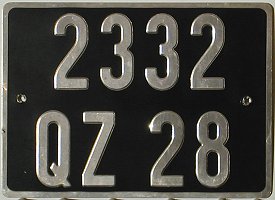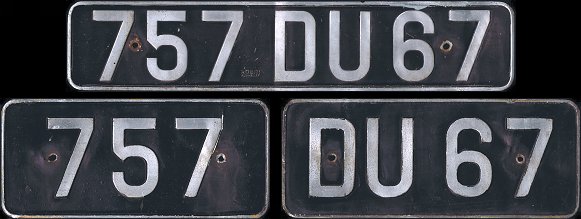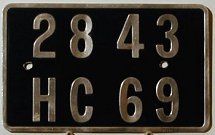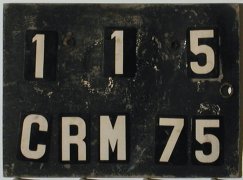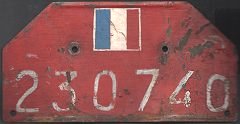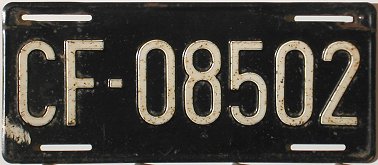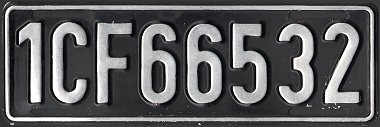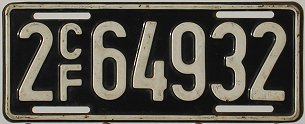| | 1950-2009 normal series plates, reflective style |
 |
17 = Charente-Maritime.
After having been optional before, reflective plates became mandatory in 1993. Front plates had to be white, rear plates yellow. |
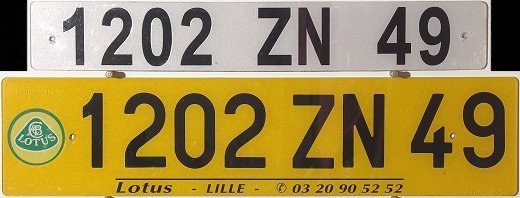 |
49 = Maine-et-Loire.
This pair obviously was on a Lutus car. The front plate is smaller than legally allowed, probably to complement the aerodynamics of the sports car. |
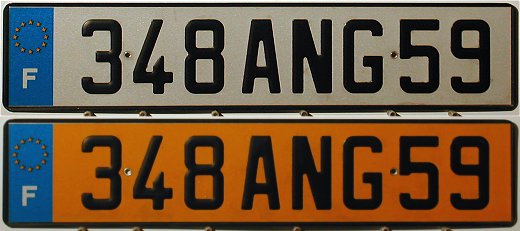 |
59 = Nord.
After having been optional before, the Euroband became mandatory in 2004. Front plates became the same size as rear plates. |
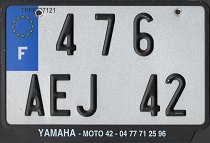 |
Motorcycle plate, 42 = Loire.
The Euroband has been mandatory since 2004, white rear plates were optionally permitted in 2007. |
| | Special series plates |
 |
Pre-2009 agricultural tractor plate, 28 = Eure-et-Loire.
A farm-specific number was followed by the department code. All tractors belonging to one farm had the same number. Since 2009 tractors receive individual normal series numbers. |

 |
Official vehicle plates
Top: Pre-1992 official vehicle front plate. Number above 30000: Authority other than the central administration.
Bottom: 1992-2009 official vehicle rear plate. 33 = Gironde, R = permitted to circulate in the region (Aquitaine) and in adjoining regions.
With the introduction of the 2009 central system official plates were abolished, these vehicles now carry normal numbers. |
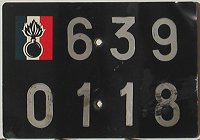
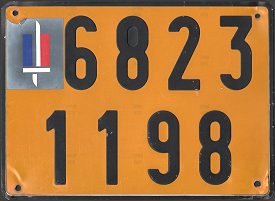 |
Military and gendarmerie plates
Top: Gendarmerie motorcycle plate. 6 = army and gendarmerie, 3 = 1973, 9 = motorcycle.
Bottom: Army rear plate. 6 = army and gendarmerie, 82 = 1982, 3 = truck, tractor or other machine.
With the introduction of the 2009 central registration system these plates were restricted to combat vehicles. Civilian type vehicles now usually receive normal series plates. |
 |
Diplomatic front plate. 100 = Senegal. |
 |
Consular rear plate. 59 = Israel, 75 = Ville de Paris. |
| | Temporary, provisional and trade plates |
 |
Temporary rear plate, 75 = Ville de Paris. Before 1984, the expiration date was not shown on the plate |
 |
Temporary rear plate,expiring January 1989, IT = foreign cultural staff and the like, 01 = Ain. IT series plates are the only French plates using the letter I. |

 |
Provisional numbers in the form of a sticker, 92 = Essonne. |
 |
Provisional number. WW2 = valid for export out of France, 75 = Ville de Paris. |
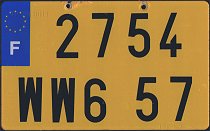 |
Provisional motorcycle plate. 57 = Moselle.
This is an error plate, there never was a WW6 series. Most likely the number was actually WWG. |
 |
1969-1995 plate for car imported from Germany.
When a French bought a used car in Germany, he could keep the German number (on a yellow plate) for four months to drive in France. This practice was unofficial. Although this plate has a German number and was made in Germany, I decided to consider it French, because its legal (or at least customary) basis is French. |
 |
2009 onwards provisional plate. 33 = Gironde, Aquitaine Region. |
 |
2009 onwards trade plate. 33 = Gironde, Aquitaine Region. |
 |
2009 onwards temporaty plate, expiring November 2009. |




